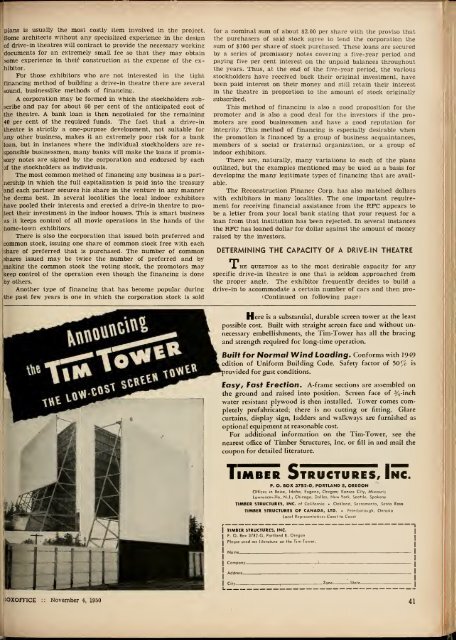Boxoffice-11.04.1950
You also want an ePaper? Increase the reach of your titles
YUMPU automatically turns print PDFs into web optimized ePapers that Google loves.
i<br />
j<br />
plans is usually the most costly item involved in the project.<br />
Some architects without any specialized experience in the design<br />
of drive-in theatres will contract to provide the necessary working<br />
documents for an extremely small fee so that they may obtain<br />
some experience in their construction at the expense of the exhibitor.<br />
For those exhibitors who are not interested in the tight<br />
financing method of building a drive-in theatre there are several<br />
sound, businesslike methods of financing.<br />
A corporation may be formed in which the stockholders subscribe<br />
and pay for about 60 per cent of the anticipated cost of<br />
the theatre. A bank loan is then negotiated for the remaining<br />
40 per cent of the required funds. The fact that a drive-in<br />
theatre is strictly a one-purpose development, not suitable for<br />
any other business, makes it an extremely poor risk for a bank<br />
loan, but in instances where the individual stockholders are responsible<br />
businessmen, many banks will make the loans if promisjsory<br />
notes are signed by the corporation and endorsed by each<br />
lof the stockholders as individuals.<br />
The most common method of financing any business is a partnership<br />
in which the full capitalization is paid into the treasury<br />
and each partner secures his share in the venture in any manner<br />
he deems best. In several localities the local indoor exhibitors<br />
have pooled their interests and erected a drive-in theatre to pro-<br />
Itect their investment in the indoor houses. This is smart business<br />
as it keeps control of all movie operations in the hands of the<br />
home-town exhibitors.<br />
There is also the corporation that issued both preferred and<br />
common stock, issuing one share of common stock free with each<br />
share of preferred that is purchased. The number of common<br />
shares issued may be twice the number of preferred and by<br />
making the common stock the voting stock, the promotors may<br />
keep control of the operation even though the financing is done<br />
by others.<br />
Another type of financing that has become popular during<br />
the past few years is one in which the corporation stock is sold<br />
for a nominal sum of about $2.00 per share with the proviso that<br />
the purchasers of said stock agree to lend the corporation the<br />
sum of $100 per share of stock purchased. These loans are secured<br />
by a series of promissory notes covering a five-year period and<br />
paying five per cent interest on the unpaid balances throughout<br />
the years. Thus, at the end of the five-year period, the various<br />
stockholders have received back their original investment, have<br />
been paid interest on their money and still retain their interest<br />
in the theatre in proportion to the amount of stock originally<br />
subscribed.<br />
This method of financing is also a good proposition for the<br />
promoter and is also a good deal for the investors if the promoters<br />
are good businessmen and have a good reputation for<br />
integrity. This method of financing is especially desirable when<br />
the promotion is financed by a group of business acquaintances,<br />
members of a social or fraternal organization, or a group of<br />
indoor exhibitors.<br />
There are, naturally, many variations to each of the plans<br />
outlined, but the examples mentioned may be used as a basis for<br />
developing the many legitimate types of financing that are available.<br />
The Reconstruction Finance Corp. has also matched dollars<br />
with exhibitors in many localities. The one important requirement<br />
for receiving financial assistance from the RFC appears to<br />
be a letter from your local bank stating that your request for a<br />
loan from that institution has been rejected. In several instances<br />
the RF

















